Sales CV Template + Examples for 2025
From a sales assistant CV to a sales executive CV: see how to write a winning sales CV. It's up to you to do the hard sells in between level-ups.
Our customers were hired by:
Regardless of where you are in your career, writing a CV is a challenge. There’s so much competition for the best jobs that the pressure is immense. What’s worse, you sit down to write and it’s hard to even decide what to include in a CV.
But you’re about to learn that it’s easy to make that decision when you know what to put on a CV to impress the recruiter. Ultimately, your CV is more than just a document with a chronological list of your professional journey.
In this guide, you'll get the right advice on what to put in a CV to make it stand out, including all the details for each of the CV sections. You'll also see a dedicated example which can serve as a template.
Create an effective CV in minutes. Choose a professional CV template and fill in every section of your CV in a flash using ready-made content and expert tips.
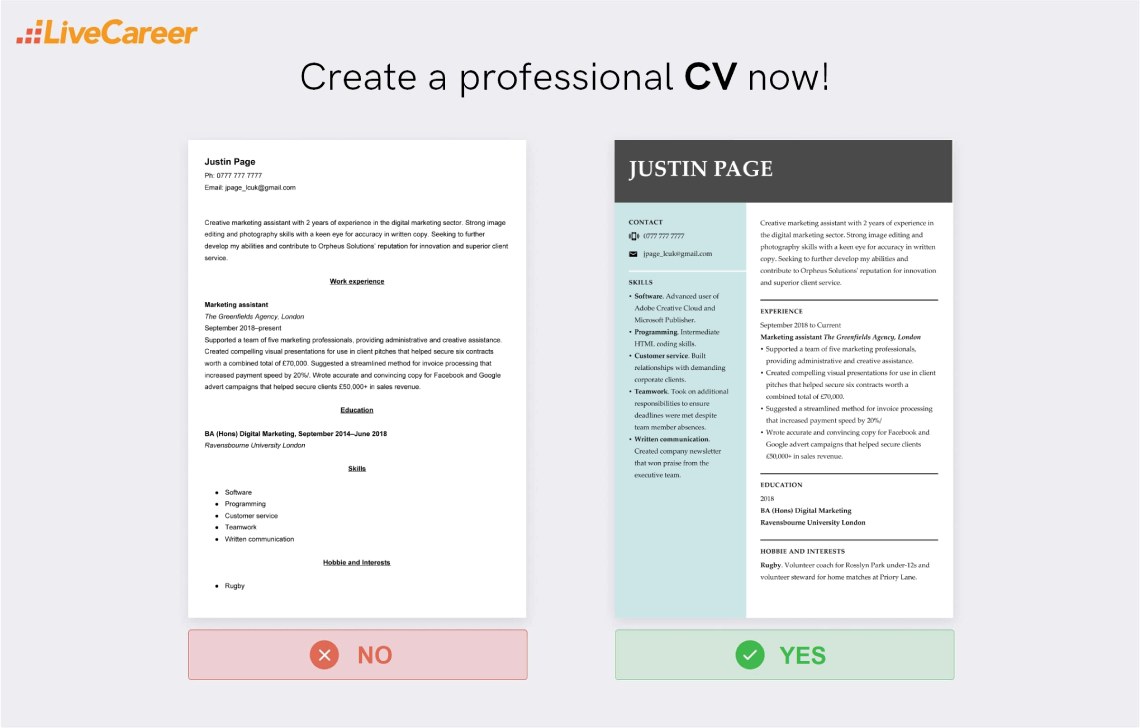
We created the sample on the right using our builder. See other good CV examples like this one.
Need more help with your CV? We recommend the following guides:
Having examined 6 million CVs created in our builder, we found that*:
*The data comes from a period of the last 12 months (August 2023-August 2024).
Justin Page
Ph: 0777 777 7777
Email: jpage_lcuk@gmail.com
Creative marketing assistant with 2 years of experience in the digital marketing sector. Strong image editing and photography skills with a keen eye for accuracy in written copy. Seeking to further develop my abilities and contribute to Orpheus Solutions’ reputation for innovation and superior client service.
Work experience
Marketing assistant
The Greenfields Agency, London
September 2018–present
Education
BA (Hons) Digital Marketing, September 2014–June 2018
Ravensbourne University London
Skills
Hobbies and Interests
Regardless of the job you are applying for, there are certain sections that every CV should have. What are the 5 main things your CV should include?
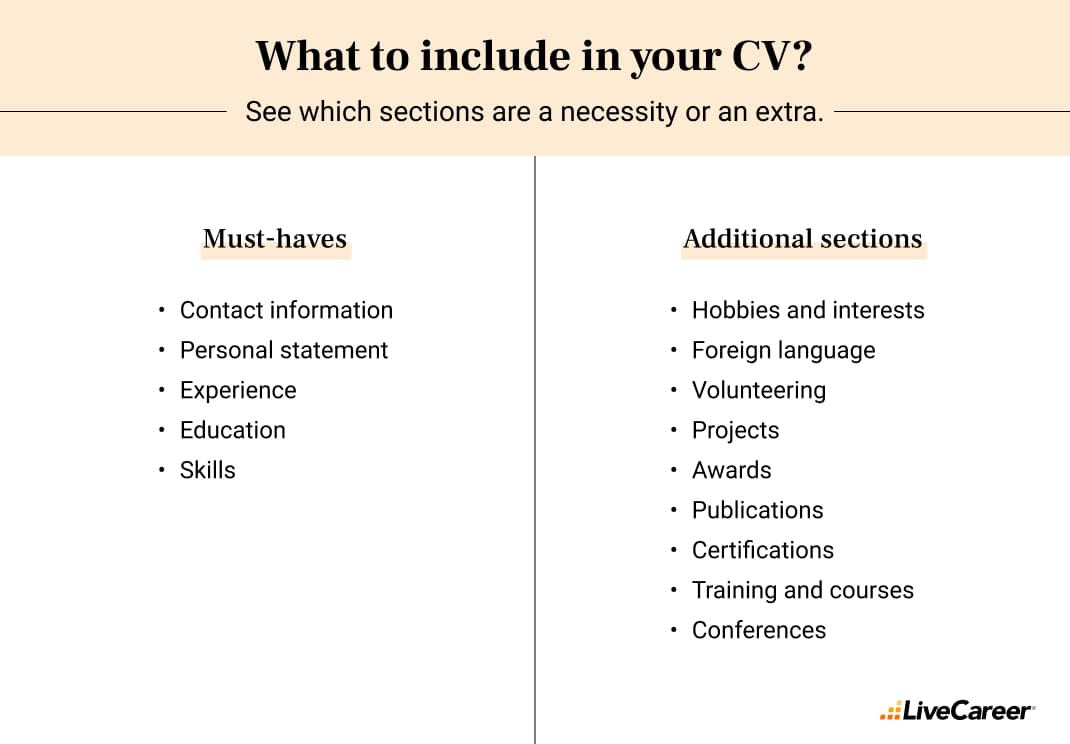
Those are must-haves. If you don't put them on your CV, it will most like be rejected in a second. To make your CV stand out, there are additional sections you can put on your CV, too.
Putting such things in your CV can show that you are serious about the job and you are the best fit.
Now, let's take a quick look at what exactly to put in each of the CV sections.
Writing your first CV? Here are the CV sections to put on a CV. They’re arranged in order as they should appear on your CV, from top to bottom.
Your contact information should be put in the CV header. It contains your personal details, and you should include there:
And a gentle reminder, don’t include your picture and a postal address as it just wastes precious space, especially if you’re aiming to write a one-page CV. And leave out personal information like date of birth etc, as it just leaves you open to discrimination.
Justin Page
Ph: 0777 777 7777
Email: jpage_lcuk@gmail.com
Now for the first substantive section of your CV you need to write a personal statement. It’s also known as a CV summary or CV profile and it’s an introduction to you as a candidate.
You have to structure it in such a way that you convince the hiring manager you meet the basic requirements of the job you’re applying for. And the best way to decide what to include in a CV personal statement is to answer these questions.
So in the first sentence of your CV introduction, mention your job title and how much experience you have. Then mention skills or experience that match the job requirements.
You can do this by referring to the job advert, noting the key requirements and then choosing a professional accomplishment or skill of your own that matches. And finish off by stating how you plan to grow, develop and contribute to your new employer.
Creative marketing assistant with 2 years of experience in the digital marketing sector. Strong image editing and photography skills with a keen eye for accuracy in written copy. Seeking to further develop my abilities and contribute to Orpheus Solutions’ reputation for innovation and superior client service.
A strong CV summary will convince the recruiter you’re the perfect candidate. Save time and choose a ready-made personal statement written by career experts and adjust it to your needs in the LiveCareer CV builder.
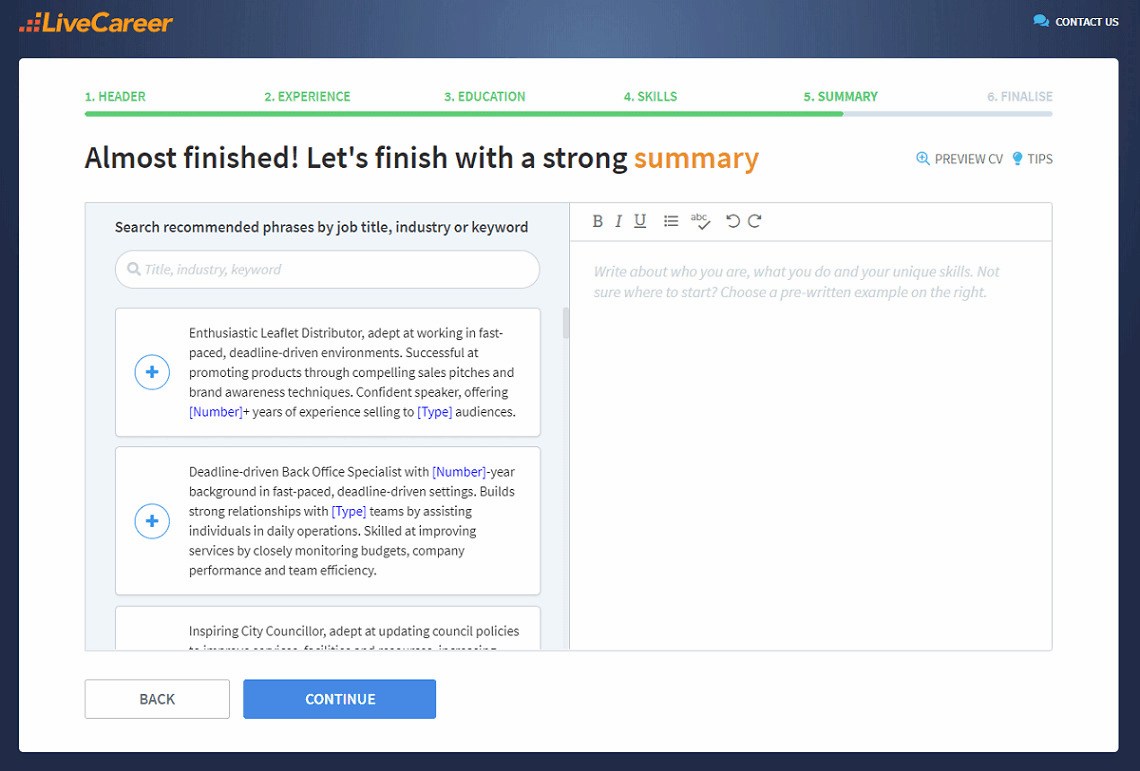
Work experience is the one of the most important sections of a CV structure, the one recruiters will pay the most attention to. So it pays to get it right.
Your work history should be written in reverse chronological order, starting with your most recent job first and working backwards from there. Then for each entry include your job title, the name of your employer and your dates of employment, using ‘Present’ as the end date if you still work there.
Then follow up with up to six bullet points that describe the job. However, don’t fall into the trap of just describing your duties with a long list of ‘responsible for’.
Give them added impact by starting off each bullet point with a CV action verb and structuring them with accomplishment statements. And give your achievements even more strength by quantifying them with numbers where possible.
Marketing assistant
The Greenfields Agency, London
September 2018–Present
It’s often overlooked, but your education section is absolutely essential to put in your CV. Here’s what you need to include.
If you’re a university graduate or still studying, then include the name of your degree, the name of your university and your dates of study. Include an expected graduation date if you’re still studying.
If you’re a school leaver, then include your A-levels, mentioning each subject completed, the name of your school or college and your dates of study. GCSEs are only required if you’re still studying or are writing a recent school leaver CV.
In that case just list the number of GCSE subjects you completed and only mention maths and English specifically. That’s because they’re often considered a basic entry-level requirement.
And there’s some flexibility with this section too. You can change your CV format if you’re still studying or a recent graduate and put your education section first, before your work experience.
You could also mention specific university modules, projects or extracurricular activities if they’re relevant to the job you’re targetting.
BA (Hons) Digital Marketing, September 2014–June 2018
Ravensbourne University London
What skills to put on a CV? The ones that are relevant to the job you’re applying for of course. So make a start by listing your own skills.
Next, highlight all the skills mentioned in the job advert and note any general transferable skills that would be applicable too. Then choose 5–10 of your own skills that match up with the job requirements to include on your CV.
You can also add a short sentence for each skill that demonstrates your abilities.
Try for a good mix of soft skills and hard skills, and if in doubt remember that some skills are pretty much universal. For example, IT skills and communication skills will look good on every CV.
As the name suggests, it’s not strictly essential to include additional sections in your CV. But it is essential if you want to succeed.
Adding extra sections is a way of distinguishing yourself as an individual and adding even more proof of what a capable candidate you are.
Good ideas include a hobbies and interests section, foreign languages and volunteering. You could also consider awards, certificates, projects and conferences. As long as it is relevant to the job and adds to the argument that you’re a good candidate it’s worth including.
A CV that’s written to UK standards should not include the following sections:
A CV isn’t simply a list of sections, there’s more to it than that. It has to look good and be easy to read too, and the way to do that is with an effective CV layout. Follow these simple rules and you’ll have included all the elements you need for a perfect CV structure.
Here we have another example of where what not to include in a CV is just as important as what you do include. In this case it’s all about how you create white space on the page to frame your content, it improves readability and makes your basic CV template more visually appealing.
All you need to do is set your page margins to one inch on all four sides, set line spacing at 1.15 and double space between CV sections. That way you’ll create the perfect balance between content and white space.
Your choice of font is also a critical consideration when deciding what to include in a CV. And it’s not just for looks, your CV font type actually alters the way you retrieve information from the page. In other words, a good font makes it easier for the recruiter to find the information they need and discover why you’re the best candidate.
But you don’t need to do anything fancy. The good old reliable classics are your best choice. We’d recommend sticking with dependable choices like Times New Roman, Arial, Garamond and Helvetica.
It’s not just about what to include in a CV, it’s also about how much to include. The best CV length is 1–2 pages. Go for a one page CV if you’re a fresh graduate or school leaver. It’s also a good choice for candidates with less than five years of experience.
Go for a two-page CV if you have more than five years of experience. And if you’ve got 10 or more years of experience and you’re targeting a senior position or you’re in a technically complex role then you could even stretch to a three-page CV.
Specialist formats such as an academic CV or a medical CV could be even longer, but for the majority of candidates 1–2 pages is the ideal CV length.
When you’re finished writing it’s important to keep your layout looking perfect. The best way to do that is to save your CV in PDF format unless the job advert requests otherwise. That way you can be sure that absolutely everything you’ve decided to include in your CV stays intact.
You don’t have to be a CV writing expert. In the LiveCareer CV builder you’ll find ready-made content for every industry and position, which you can then add with a single click.
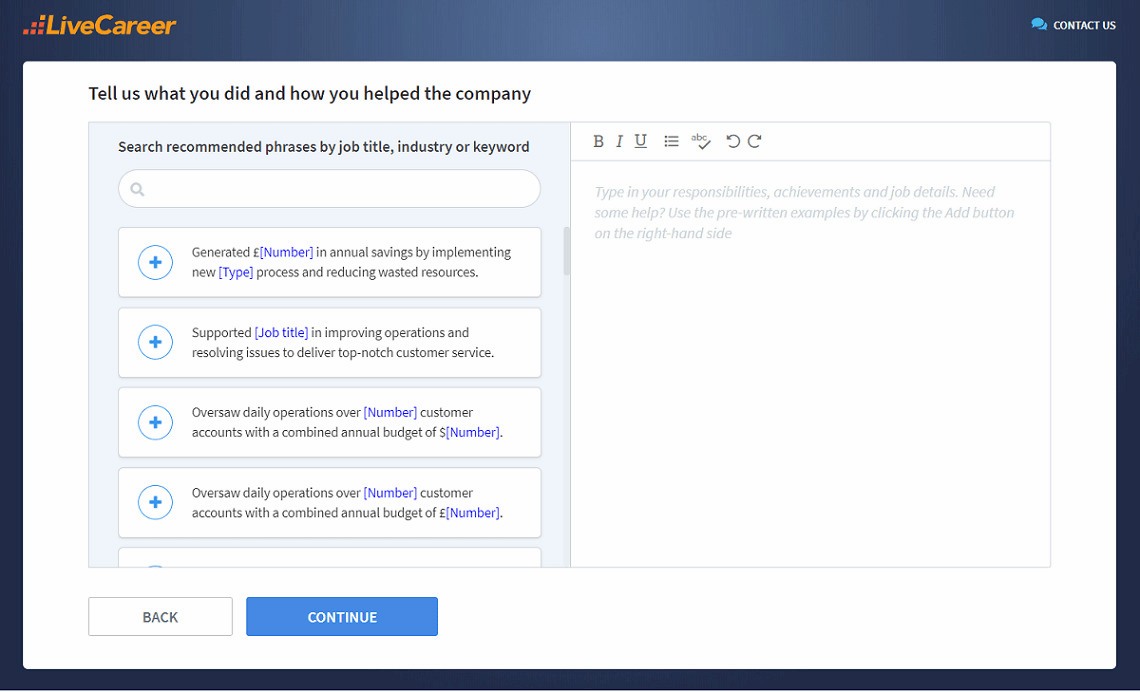
Thanks for reading. If there’s anything else you want to know about what to include in a CV, please ask in the comments section and we’ll be happy to help.
Our editorial team has reviewed this article for compliance with Livecareer’s editorial guidelines. It’s to ensure that our expert advice and recommendations are consistent across all our career guides and align with current CV and cover letter writing standards and trends. We’re trusted by over 10 million job seekers, supporting them on their way to finding their dream job. Each article is preceded by research and scrutiny to ensure our content responds to current market trends and demand.
About the author
Since 2013, the LiveCareer UK team has shared the best advice to help you advance your career. Experts from our UK editorial team have written more than one hundred guides on how to write the perfect CV or cover letter.
Rate this article:
What to include in a cv
Average:
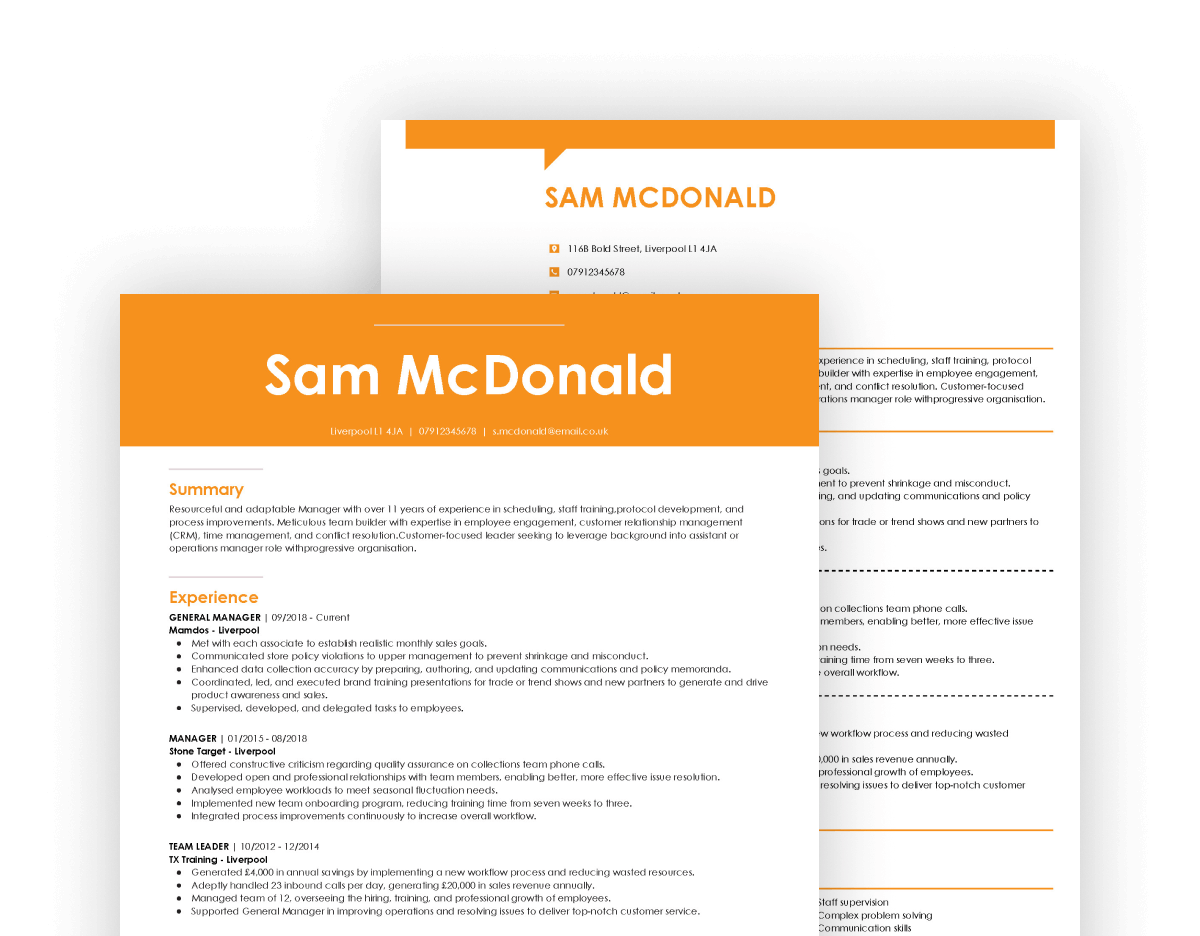
From a sales assistant CV to a sales executive CV: see how to write a winning sales CV. It's up to you to do the hard sells in between level-ups.
A data-driven CV worthy of a data analyst title. See a dedicated data analyst CV example for a graduate, a junior analyst, and a senior professional.
How to write a warehouse operative CV? Check out our CV for warehouse operative applications and warehouse operative CV example.
Our customers were hired by: